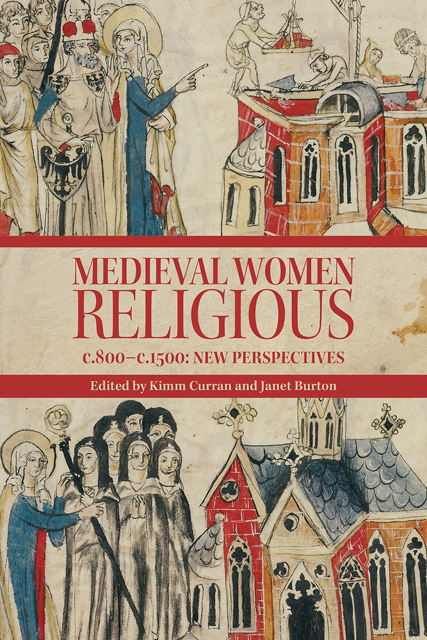Book contents
- Frontmatter
- Contents
- Illustrations
- Contributors
- Preface
- Abbreviations
- Introduction
- 1 Reform, Change, and Renewal: Women Religious in the Central Middle Ages, 800–1050
- 2 New Movements of the Twelfth Century: Diversity, Belonging, and Order(s)
- 3 Change and Renewal: Mendicants and Tertiaries in Later Medieval Europe
- 4 On the Fringes: Anchorites
- 5 ‘Quasi-religious’: Vowesses
- 6 Authority and Agency: Women as Heads of Religious Houses
- 7 Women Religious, Secular Households: The Outside World and Crossing Boundaries in the Later Middle Ages
- 8 Literacies, Learning, and Communal Reform: The Case of Alijt Bake
- 9 Family and Friends: Gift-giving, Books, and Book Inscriptions in Women’s Religious Communities
- 10 Communities of Medieval Religious Women and Their Landscapes
- 11 Materiality and Archaeology of Women Religious
- 12 Between Collective Memory and Individual Remembrance in Women’s Religious Communities
- Select Bibliography
- Index
- Miscellaneous Endmatter
12 - Between Collective Memory and Individual Remembrance in Women’s Religious Communities
Published online by Cambridge University Press: 08 June 2023
- Frontmatter
- Contents
- Illustrations
- Contributors
- Preface
- Abbreviations
- Introduction
- 1 Reform, Change, and Renewal: Women Religious in the Central Middle Ages, 800–1050
- 2 New Movements of the Twelfth Century: Diversity, Belonging, and Order(s)
- 3 Change and Renewal: Mendicants and Tertiaries in Later Medieval Europe
- 4 On the Fringes: Anchorites
- 5 ‘Quasi-religious’: Vowesses
- 6 Authority and Agency: Women as Heads of Religious Houses
- 7 Women Religious, Secular Households: The Outside World and Crossing Boundaries in the Later Middle Ages
- 8 Literacies, Learning, and Communal Reform: The Case of Alijt Bake
- 9 Family and Friends: Gift-giving, Books, and Book Inscriptions in Women’s Religious Communities
- 10 Communities of Medieval Religious Women and Their Landscapes
- 11 Materiality and Archaeology of Women Religious
- 12 Between Collective Memory and Individual Remembrance in Women’s Religious Communities
- Select Bibliography
- Index
- Miscellaneous Endmatter
Summary
Women, especially women religious, created individual, collective, and histor-ical memory and, over the last two decades, their roles have gained increas-ing scholarly attention. There has been a flourishing of studies analysing women and the organisation of funerary memory, women commissioners and producers of chronicles, liturgical and devotional books, and other narrative sources, arte-facts of material culture from memorial stones to sacred vessels, and architecture. These studies demonstrate how women created, reinvented, or even erased the past by consciously selecting some elements and concealing others, and also how men and women collaborated in the memorial tradition of the Middle Ages. Women who acted as patrons self-consciously manipulated liturgy, artworks, buildings, and spaces to shape their own, or their families’, remembrance, and their dynastic iden-tity. In the case of religious women, commemoration of their kin converged with the memory of their communities. Both of them were types of a collective and identity-oriented memorialisation developed since the Early Middle Ages, which coexisted with a later form of commemoration, a more individual one that entailed intercession, in the form of prayers, and donations, to shorten the time of the deceased in Purgatory. These have to be studied together as women had an active role in the making ‘multifaceted memory’ that in some cases commemorated at the same time, a dynasty, a religious community, and an individual.
The role of women as memory keepers of their families, through the foundation of monasteries, donations, and the institution of anniversaries for the deceased, has been explored in different territories, although further comparative analysis between diverse monastic landscapes by adopting a gender perspective is still nec-essary. Many ‘elite’ women's monastic communities worked as bastions of dynastic familial memory since the Early Middle Ages, and by the Central Middle Ages these foundations suffered significant changes as they passed from being ‘family monas-teries’, closely ruled by members of the aristocracy, to being incorporated into the reforms based on the Rule of St Benedict and especially into the Cistercian Order. However, their role as funerary memorials for the aristocracy or the royalty contin-ued, and women collaborated with the new reformed orders in the commemoration of their lineage, as they would do later with the mendicants.
- Type
- Chapter
- Information
- Medieval Women Religious, c.800-c.1500New Perspectives, pp. 202 - 220Publisher: Boydell & BrewerPrint publication year: 2023



